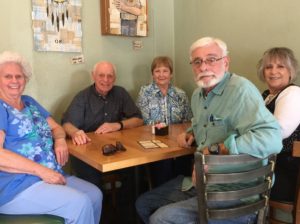Family

This picture is the Friday Night Club waiting for dinner. Sherry and I got together yesterday with my sister, brother, sister-in-law and cousin. Let’s call it a small part of the family of Dan. That’s a miniscule part of the family of man. Before you roll your eyes and quit reading, let me explain. After taking my malaria pill this morning, I fought my way through two airports and now, sardined into an airline seat, I’m underway on a trip to the other side of the world, typing to the whine of the engines while bumping through turbulence.
So, as I look around at my fellow travelers, that has me thinking about family, extended family and tribes we identify with — groups I’ve found myself in from grade school through the Navy and beyond. I don’t expect to have a problem assimilating into The College of the Ozarks group I’ll meet up with in San Francisco. After all, I did go to college once . . . a long time ago. And I was a part of that large tribe called the military with all its branches and subdivisions. Looking forward to meeting the Vietnam Veterans in our group. That tribe bonds around taking enemy fire in a common war.





